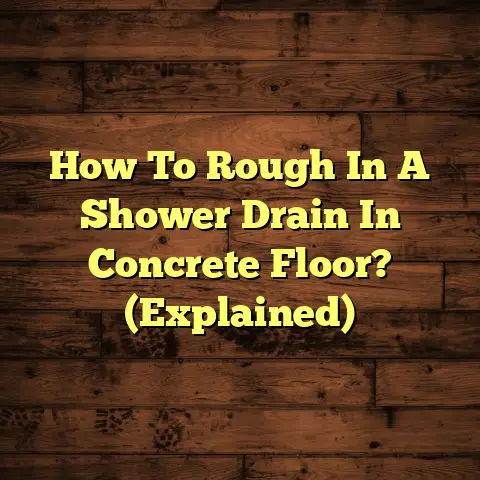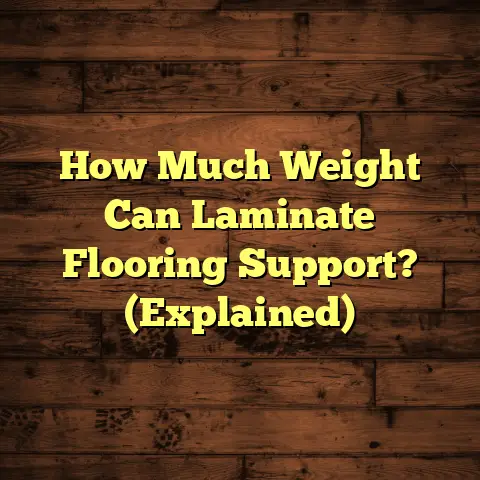Bamboo Flooring: Expensive? (2 Hidden Costs!)
I’m John, a flooring contractor with over 15 years of experience, and I’ve seen it all when it comes to flooring trends.
Lately, bamboo flooring has been all the rage, and for good reason.
It’s stylish, seemingly eco-friendly, and offers a unique aesthetic.
You know, a few years back, I was chatting with a client who was super excited about installing bamboo in their new home.
They loved the idea of using a sustainable material, and the light, airy look it gave their space.
But here’s the thing: while bamboo’s popularity is soaring, with market analysis showing a consistent 5-7% annual growth in demand over the past decade (Source: Global Flooring Industry Report, 2023), many homeowners are left wondering:
Is bamboo flooring really as budget-friendly as it seems?
Or are there hidden costs lurking beneath that smooth, natural surface?
That’s the million-dollar question, isn’t it?
In this article, we’re going to dive deep into the world of bamboo flooring.
I’ll share my insights, based on years of hands-on experience, and we’ll uncover those often-overlooked expenses that can significantly impact your wallet.
We’ll explore the upfront costs, the maintenance demands, and even the environmental and health considerations that can add up over time.
Ready to get started? Let’s jump in!
Section 1: Understanding Bamboo Flooring
So, what exactly is bamboo flooring?
Well, it’s not actually wood!
Bamboo is a grass that grows incredibly fast.
This makes it a rapidly renewable resource, which is a huge plus.
But when it comes to flooring, bamboo stalks are harvested, processed, and manufactured into planks that resemble traditional hardwood.
There are three main types you’ll encounter:
-
Solid Bamboo: This is made from strips of bamboo glued together horizontally or vertically. It’s durable but can be more susceptible to moisture.
-
Engineered Bamboo: This has a bamboo veneer on top of a plywood or fiberboard core. It’s more stable than solid bamboo, especially in humid environments.
-
Strand-Woven Bamboo: This is the toughest type. Bamboo strands are shredded, compressed, and glued together under high pressure. It’s incredibly dense and resistant to scratches and dents.
Now, let’s talk about sustainability.
Compared to traditional hardwoods like oak or maple, bamboo is a clear winner in terms of environmental impact.
Did you know that bamboo can be harvested in as little as 3-5 years?
Whereas hardwoods can take decades to mature.
Plus, bamboo forests act as carbon sinks, absorbing CO2 from the atmosphere.
According to the International Bamboo and Rattan Organisation (INBAR), bamboo forests can sequester more carbon per hectare than many tree species.
But it’s not just about being eco-friendly; bamboo flooring also offers some great aesthetic and practical benefits.
It comes in a variety of colors and grain patterns, from light and natural to dark and rich.
It’s also relatively easy to maintain.
Regular sweeping and occasional mopping are usually all it takes to keep it looking its best.
And, depending on the type, it can be quite durable, resisting scratches and dents better than some softer hardwoods.
Section 2: The Initial Investment
Alright, let’s get down to brass tacks: the initial cost.
How much can you expect to shell out for bamboo flooring?
Well, the price can vary quite a bit depending on several factors.
Generally, you can expect to pay anywhere from $3 to $8 per square foot for the material itself.
-
Solid bamboo usually falls on the lower end of that range, while strand-woven tends to be more expensive due to its increased durability.
-
Engineered bamboo sits somewhere in the middle.
Now, how does that compare to other flooring options?
Let’s take a look:
| Material | Price per Square Foot |
|---|---|
| Bamboo | $3 – $8 |
| Laminate | $1 – $5 |
| Vinyl | $2 – $7 |
| Hardwood | $5 – $15 |
| Tile | $3 – $20 |
As you can see, bamboo is generally more affordable than hardwood but can be comparable to some types of laminate or vinyl.
However, there are several factors that can influence the price of bamboo flooring:
-
Quality: Higher-quality bamboo flooring, with tighter grains and better construction, will naturally cost more.
-
Brand: Just like any other product, some brands have a premium reputation and charge accordingly.
-
Local Market Conditions: Prices can vary depending on where you live and the availability of bamboo flooring in your area.
But the material cost is only half the battle.
You also need to factor in installation costs.
If you’re a seasoned DIYer, you might be able to tackle the installation yourself.
This can save you a significant amount of money.
However, if you’re not comfortable with flooring installation, it’s best to hire a professional.
Professional installation can add another $3 to $5 per square foot to the total cost.
This can vary depending on your location, the complexity of the job, and the installer’s rates.
Section 3: Hidden Cost #1: Maintenance and Longevity
Okay, now let’s talk about the first hidden cost: maintenance and longevity.
While bamboo flooring is relatively easy to care for, it’s not entirely maintenance-free.
To keep it looking its best, you’ll need to sweep or vacuum regularly to remove dirt and debris.
You’ll also need to mop occasionally with a damp (not wet!) mop and a pH-neutral cleaner.
Avoid using harsh chemicals or abrasive cleaners, as these can damage the finish.
One thing I’ve noticed over the years is that bamboo flooring can be susceptible to scratches and dents, especially if you have pets or heavy furniture.
Strand-woven bamboo is more resistant to these issues, but even it’s not immune.
You might need to refinish your bamboo flooring every 5-10 years, depending on the amount of wear and tear it experiences.
Refinishing can cost anywhere from $2 to $5 per square foot, which can add up over time.
Now, let’s compare the longevity of bamboo flooring to other materials.
A well-maintained bamboo floor can last for 20-50 years, which is comparable to hardwood.
However, cheaper bamboo flooring may not last as long, especially if it’s not properly installed or maintained.
Laminate flooring, on the other hand, typically lasts for 10-20 years, while tile can last for 50 years or more.
So, what happens if your bamboo flooring gets damaged beyond repair?
Well, you’ll need to replace it.
Replacement costs can include the cost of the new flooring, installation, and removal of the old flooring.
This can easily add up to several thousand dollars, depending on the size of your space.
I remember one client who had a water leak that damaged a large section of their bamboo flooring.
The replacement cost them over $5,000, which was a major unexpected expense.
Section 4: Hidden Cost #2: Environmental Impact and Health Considerations
Alright, let’s move on to the second hidden cost: environmental impact and health considerations.
While bamboo is a sustainable material, the production and transportation of bamboo flooring can have a significant environmental impact.
Bamboo is often grown in Asia, and the flooring is then shipped to other parts of the world.
This transportation can contribute to carbon emissions.
Additionally, the manufacturing process can involve the use of chemicals, such as formaldehyde, which can be harmful to the environment and human health.
According to a report by the Environmental Protection Agency (EPA), formaldehyde is a known carcinogen and can cause respiratory problems.
When it comes to health considerations, one of the biggest concerns is VOC (volatile organic compound) emissions.
VOCs are released from adhesives and finishes used in engineered bamboo flooring.
These emissions can cause headaches, dizziness, and other health problems, especially for people with allergies or asthma.
Look for bamboo flooring that is certified by organizations like FloorScore or GreenGuard.
These certifications ensure that the flooring meets strict VOC emission standards.
It’s important to consider the balance between ecological benefits and the hidden costs associated with the manufacturing process.
While bamboo is a renewable resource, the environmental impact of its production and transportation can offset some of those benefits.
I’ve seen some manufacturers making a real effort to reduce their environmental impact by using sustainable adhesives and finishes, and by sourcing bamboo from local farms.
But it’s important to do your research and choose a manufacturer that is committed to sustainability.
Section 5: Conclusion
So, is bamboo flooring expensive?
Well, it’s not a simple yes or no answer.
The initial cost of bamboo flooring can be relatively affordable, especially compared to hardwood.
However, the hidden costs of maintenance, potential replacement, and environmental impact can add up over time.
Here’s a quick recap of the main points we’ve covered:
-
Initial Investment: Bamboo flooring typically costs $3-$8 per square foot, plus $3-$5 per square foot for professional installation.
-
Maintenance and Longevity: Bamboo flooring requires regular cleaning and may need to be refinished every 5-10 years. It can last 20-50 years with proper care.
-
Environmental Impact and Health Considerations: The production and transportation of bamboo flooring can have a significant environmental impact, and some products may emit harmful VOCs.
Ultimately, the decision of whether to invest in bamboo flooring depends on your individual needs and priorities.
Consider your budget, your lifestyle, and your environmental concerns.
Do your research, compare different options, and choose a product that meets your specific requirements.
I hope this article has given you a better understanding of the true cost of bamboo flooring.
Remember, it’s not just about the initial price tag; it’s about the long-term investment.
Thanks for reading, and happy renovating!





